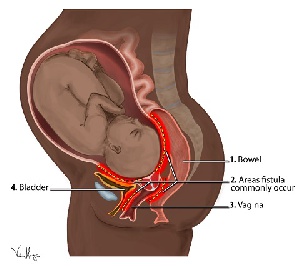- Home - News
- TWI News | TV
- Polls
- Year In Review
- News Archive
- Crime & Punishment
- Politics
- Regional
- Editorial
- Health
- Ghanaians Abroad
- Tabloid
- Africa
- Religion
- Election 2020
- Coronavirus
- News Videos | TV
- Photo Archives
- News Headlines
- Press Release
Opinions of Thursday, 23 May 2019
Columnist: Dr. Gabriel Y.K Ganyaglo
International Day to end Obstetric Fistula (IDEOF) 2019 – basic facts on obstetric fistula
Preamble
Since 2013, the UN set 23rd May to be observed as the International Day to End Obstetric Fistula (IDEOF). This promotes global actions to prevent and end obstetric fistula. A condition that affects only women and girls in underdeveloped regions of the world. Each year, the global effort is galvanized around a theme. This year, “fistula is a human rights violation, end it now” is the theme chosen.
What is Obstetric Fistula (OF)?
Obstetric fistula is an abnormal hole between the birth canal and the bladder (in front). Or between the birth canal and the rectum (behind). Or both. When this happens, the contents of the bladder (urine) leak through the birth canal. Or the contents of the rectum (faeces) leak through the birth canal. Or both urine and faeces may leak through the birth canal.
The birth canal is not the usual channel for these excrements to leave the body. Normally, you can control the passage of urine through the pee-hole. You can also control the passage of faeces through the anus. Through the birth canal there is no control. In effect, the individual leaks urine and or faeces uncontrollably all the time.
We all know the smell of urine and the smell of faeces. If an individual loses control of the exit of these excrements, that individual smells of urine or faeces or both all the time.
How big a problem is obstetric fistula?
Globally 2 million women and girls are estimated to be suffering from obstetric fistula with about 50,000 to 100,000 new cases developing each year. In Ghana it is estimated that about 1,300 new cases of obstetric fistula develop every year. Due to many factors only about 200 cases are repaired every year in Ghana leaving a significant backlog of cases. Obstetric fistula has been reported from all the 16 regions of Ghana including Greater Accra. Wherever labour is difficult and there is no recourse to timely caesarean section, obstetric fistula can result. However obstetric fistula is more common in the northern parts of Ghana.
What causes OF?
Obstetric fistula is caused by prolonged obstructed labour. When labour is obstructed, the soft tissues of the mother’s bladder and rectum are squashed between the bones of the baby’s head and the bones of the mother’s waist. Blood supply to the squashed segment is cut off, the tissues die and a hole develops through which urine and or faeces leaks.
Labour usually should not last more than 12hours (half a day). When labour runs into days, it becomes difficult. Eventually the baby is born already dead (still born).
Labour can become obstructed (difficult) when
1. The baby is too big (Compared to the mother’s pelvis/waist)
2. The baby has not turned well
3. The baby is coming with the buttocks or other part of the body
4. The mother is short (less than 1.5m)
When labour becomes difficult/obstructed, only an emergency caesarean section can save the mother and baby.
Consequences of obstetric fistula
The women and girls who suffer from obstetric fistula smell of urine and or faeces all the time.
Due to the strong smell of urine and faeces:-
1. Their husbands abandon them, especially when the baby dies.
2. Some return to their families who keep them at arm’s length. Most families find a secluded portion of the family compound and literally ‘hide’ them there.
3. For fear of tarnishing the family honour, they are kept out of sight.
4. Friends do not go near them and others break their company when a fistula patient comes close
5. The patient’s look and feel rejected.
6. They suffer a lot of stigma and isolation from social gatherings. They cannot visit the mosque to pray, go to church, attend marriage ceremonies funerals or birthdays.
7. They lose their self-esteem as they can neither function as a wife nor a mother in society
8. They lose their source of livelihood/income.
a. No one patronizes their wares if they are traders.
b. They lose customers if hairdressers or seamstresses.
9. A few are fortunate to be tolerated by family members on their farms. They do not earn a wage for helping out on the farm. Most do not even find the strength to farm.
10. To avoid stigma, and hide the leakage, they avoid drinking which unfortunately worsens the effects on their physical health.
11. Most learn to avoid eating or eat little.
12. They suffer from depression and some consider suicide.
13. The physical effects of urine are damaging to the skin.
Most of the maltreatment fistula patients receive from the communities where they live is due to myths and misconceptions about obstetric fistula
Myths and misconceptions about the cause of obstetric fistula
1. Fistula is a curse
2. Fistula is a spiritual sickness and thus requires spiritual solutions.
a. Traditional healers try their luck
b. Spiritualists do their best often to no avail
3. Women who cheat on their husbands suffer obstructed labour.
Unless and until the woman confesses to cheating on the husband no help is offered. To get much needed help under the intense pain and distress, some have admitted to cheating on husbands when in actual fact they were innocent.
Prevention of obstetric fistula
1. Family planning.
The pregnancy that results in fistula should be wanted to start with.
2. Girl child education
With education, a girl is more likely to be gainfully employed. With economic empowerment, she can negotiate her needs in a marriage relationship. Such a girl is more likely to attend antenatal care and avoid home delivery.
3. Skilled attendance at all births.
A skilled birth attendant is able to predict if labour is likely to be difficult. They are likely to refer a laboring mother to hospital in time for life saving emergency caesarean section.
4. Avoid delays in seeking help with delivery
5. Good road networks motorable all year round
6. Easy access to well-equipped and well manned health facilities
Treatment of obstetric fistula
When seen early, and if small in size, fistula can be treated with a rubber tubing inserted into the pee- hole to drain the bladder for about one month.
Unfortunately, due to stigma, myths and misconceptions, most patients hide their condition and report late.
Poverty adds to the delay after the decision is made eventually to seek care in hospital. Transportation cost to the hospital can be challenging.
Ultimately surgery has become the main stay of treatment for obstetric fistula.
In Ghana, obstetric fistula treatment is free.
Where to go for treatment if you have obstetric fistula
Report early at any health facility and the patient will be referred appropriately. Some facilities are specialized to provide care to victims. These include:-
1. Mercy Women’s Catholic Hospital at Mankessim
2. Tamale Fistula Centre
Others include:
1. All the Teaching Hospitals in Ghana.
2. All Regional Hospitals have capacity to treat obstetric fistula. Wa and Koforidua are relatively more active.
3. Some district hospitals visited regularly by fistula surgeons like the Assemblies of God Hospital in Saboba, Baptist Medical Centre in Nalerigu and Nkwanta South District Hospital also offer periodic treatment for fistula patients.
The Gender department of the Ministry of Gender Children and Social Protection (MOGCSP) has a network of officers in all the districts and municipal areas that support transportation of fistula patients. If for any reason the patient cannot get to the treatment centre by herself, making contact with the MOGCSP official is one sure way of getting to the treatment centre.
The Gender department can be reach on toll free lines 0800 800 800 or 0900 900 900
Need for Rehabilitation
After successful surgical repair, fistula patient need rehabilitation to make them economically independent. This is the only guarantee to a successful reintegration into their communities. Many still suffer from stigma even after successful repair which is most unfortunate.
Fistula as a human right violation
Every individual has a right to enjoy the highest attainable standard of health as a fundamental human right without distinction of race, religion, political affiliation, economic or social status. Obstetric fistula patients are obviously not in good health and thus obstetric fistula is a violation of their right. Sadly it is not the fault of the patient. It is rather a failure of the health care system to guarantee access to sexual and reproductive health services. Unfortunately the patient is rather blamed for having an obstetric fistula.
Conclusion
It is not the fault of the patient that she has obstetric fistula. They need support to get cure and rehabilitation after treatment. Treatment is free and also covered by health insurance. If you know someone with fistula, help her to get cured. If you are a fistula patient please contact the nearest health facility or call the MOGSCP toll free line. To end fistula it costs money. In a setting where money is hard to come by, it is good strategy to focus on prevention. All who can support financially should get on board the fistula train to help the care and restoration of the victims of obstetric fistula.











